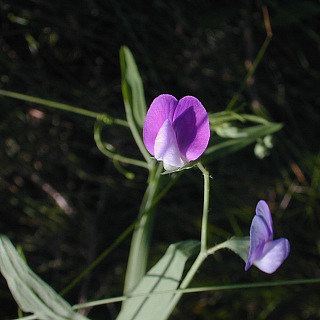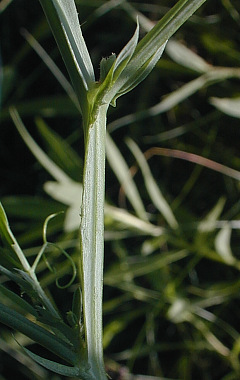Description: This annual plant is about 1-2½' tall. It is somewhat vine-like and semi-erect, relying on tendrils to cling to adjacent vegetation for support. The stems are hairless, flattened, and strongly winged, branching occasionally. The alternate compound leaves consist of a pair of leaflets that diverge from a short flat petiole. A third leaflet has been reduced to a curling tendril. The leaflets proper are ovate or oblong-ovate, hairless, and smooth along the margins. Their primary veins are parallel, while the secondary veins have a tendency to crisscross between the primary veins. The leaflets are up to 3½" long and 1" across; they are variable in size depending on their stage of maturity. At the base of each compound leaf is a pair of conspicuous stipules that are more or less lanceolate.

Small racemes of 1-3 flowers
develop from leaf axils. These flowers are ½" across or less and have a
typical pea-like structure, consisting of a standard, keel, and 2
enclosing lateral petals. These petals are various shades of purple,
purplish pink, or white; the upper petal comprising the standard is
usually a darker color than the remaining petals. The green calyx has 5
teeth with long tips. The blooming period occurs during the late spring
or summer, depending on the locality, and lasts about 1-2 months. The
seedpods are flat-sided and oblong, tapering at the tips. They are
covered with long hairs that eventually become stiff in texture. The
seedpods are initially green, but eventually turn brown and split open
to release the seeds. These seeds are orbicular, dull brown, and
somewhat flattened. This plant spreads by reseeding itself; it doesn't
form vegetative colonies.
Cultivation:
The preference is full or partial sun, mesic conditions, and fertile
loamy soil. The root nodules of this plant add nitrogen to the soil.

Range & Habitat:
The Singletary Pea is a rare plant in Illinois that has naturalized in
only a few counties in southern and central Illinois (see Distribution
Map). It was introduced into the United States from the
Mediterranean area of Europe for forage and improvement of agricultural
soil. The Singletary Pea is cultivated primarily in the southern
states,
where it is a winter annual, although in central Illinois it acts more
like a summer annual. Habitats include thickets, savannas, areas along
roadsides and railroads, edges of fields, and waste areas.
Faunal Associations:
The flowers are pollinated by bumblebees and other long-tonged bees.
Butterflies and skippers may suck nectar from the flowers, but they are
less effective at pollination. The foliage is a food source for Epicauta
fabricii (Blister Beetle sp.) and the caterpillars of the
moth Grammia oithona (Oithona Tiger Moth). The
seeds are occasionally eaten by the Bobwhite and other upland
gamebirds. White-Tailed Deer, livestock, and probably smaller
herbivores readily eat the foliage.
Photographic Location:
A savanna at Meadowbrook Park in Urbana, Illinois, where a pair of
plants appeared unexpectedly. It is doubtful that they will persist at
this site. A pair of the leaflets can be observed in the upper
photograph underneath the flowers in the background.
Comments:
Other common names of Lathyrus hirsutus are "Caley
Pea" and "Rough Pea." The hairiness of
the seedpods is a distinctive characteristic of this introduced plant
among the Lathyrus spp. (vetchlings). It resembles
two introduced species of horticulture, Lathyrus latifolius
(Everlasting Pea) and Lathyrus odoratus (Sweet
Pea), in having only a pair of leaflets per compound leaf, stems that
are flattened and winged, and flowers that are some shade of pink,
purple, or white. However, these latter species have longer stems
(often 6 ft. or more) and bigger flowers (greater than ½" across). The
Everlasting Pea is a perennial plant, while the flowers of Sweet Pea
are usually quite fragrant.